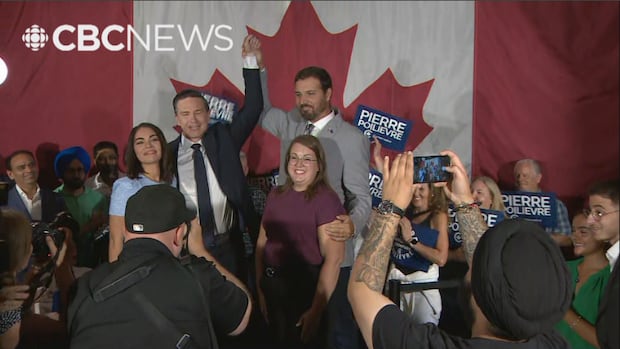Pierre Poilievre's (brief) exile is over. Now what?

In fundraising appeals sent to supporters ahead of Monday's vote, the Conservative Party billed Battle River-Crowfoot as the "most important by-election in Canadian history."
It was at least the most important byelection in the history of Pierre Poilievre. Not that the winner was ever in much doubt.
In attempting to regain a seat in the House of Commons — a chamber he first entered in 2004 at the age of 25 — Poilievre chose one of the safest ridings for a Conservative. In April, the Conservative candidate in Battle River-Crowfoot won with 83 per cent of the vote.
With the exception of the 2019 election when the right-wing People's Party of Canada took nine per cent of the vote in the riding, the Conservative Party's candidate had never won less than 80 per cent of the vote in Battle River-Crowfoot.
So that Poilievre won on Monday night with 80.4 per cent of the vote (with one polling station left to report as of Tuesday afternoon) is merely in line with what should have been expected.
But it also means Battle River-Crowfoot did not add to what has been a difficult set of data points for Poilievre over the last six months.
Can a byelection halt Poilievre's slide?In April, Poilievre's Conservatives won 41.3 per cent of the national popular vote and finished just a few points behind the Liberal Party. But recent polling suggests a bigger gap has opened up since then, with the Conservatives slipping back to 38 per cent and the Liberals climbing to 45 per cent.
Meanwhile, according to a recent survey by Nanos, Mark Carney enjoys a 28-point advantage when Canadians are asked who their preferred prime minister is — with 51.7 per cent saying Carney and just 23.7 saying Poilievre.
And all such numbers are rendered even more stark when compared to where things stood in January when the Conservatives had a 20-point lead in the polls and Poilievre seemed all but certain to become the next prime minister of Canada.
While Poilievre still has to worry about an internal leadership review in January, his win in Battle River-Crowfoot at least ensures he will be back in the familiar environs of the House as leader of the opposition when Parliament reconvenes this fall.
"This is the FINAL PUSH to get Pierre back to Parliament where he can CHALLENGE Mark Carney and the radical Liberals HEAD-ON," the Conservative Party told its supporters on Monday.
But if the Conservative Party wanted its supporters to believe this was the "most important by-election in Canadian history," it was presumably on the basis that ending Poilievre's (brief) exile from the House was a prerequisite to not just challenging the Liberals, but ultimately defeating them.
And however decisive the result in Battle River-Crowfoot, there remains the question of where Poilievre and the Conservative Party go from here.
Meet the new Poilievre, same as the old?The Conservative Party's result in April could be read in one of at least two ways.
Viewed from one angle, it might suggest the Conservatives are this close to forming government — that, if not for a remarkable confluence of events this spring, Poilievre would be prime minister.
Viewed from another angle, it might suggest that Poilievre missed his moment — that while he might have been the man for the moment in 2024, the new moment demands something quite different.
Which view you take might depend on where you sit politically. But either way, some part of the answer will likely depend on how well the Carney government performs.
And Conservatives might draw some hope from the fact the new prime minister is staring down a series of challenges with high degrees of difficulty — not just the high-stakes negotiations with the United States over trade and tariffs, but also a federal spending review, a push to accelerate major infrastructure projects and the promise of significant new housing initiatives.
Both the Carney government's capacity and the public's goodwill are going to be tested over the next several months, and the Conservatives may have opportunities to re-make the argument for change that they had seemingly won a year ago.
Whether Poilievre himself has to change has been a much-discussed question since at least the middle of this spring's election campaign. He has said that he's not for turning, but it's perhaps possible to see small hints of a slightly different approach.

In accepting victory on Monday night, Poilievre told supporters that when Parliament returns, Conservatives "will not only oppose" the Liberal government's agenda, "but we will propose real solutions." That might speak to some desire to better present the Conservatives as a "government-in-waiting."
But Poilievre and other Conservatives also recently criticized Crown prosecutors for their approach to the cases of two "Freedom Convoy" organizers. And so far, the Conservative policy prescription seems basically unchanged.
Last week, Poilievre promised to table legislation this fall that would repeal a number of Liberal environmental policies, including the cap on oil and gas emissions, the carbon price on industrial emissions, the ban on single-use plastics and the zero-emission-vehicle mandate. The ZEV mandate has replaced the carbon tax as Poilievre's object of derision, and he has framed the policy as a new front in a larger culture war.
If the government-in-waiting has a plan to reduce Canada's greenhouse gas emissions, it has yet to spell it out.
Such things didn't seem necessary a year ago when the Conservatives were leading the Liberals by 20 points. And perhaps, in time, a similar moment will come along again.
If not — if Poilievre doesn't become prime minister — Battle River-Crowfoot might go down as something less than the most important byelection in Canadian political history.
cbc.ca





